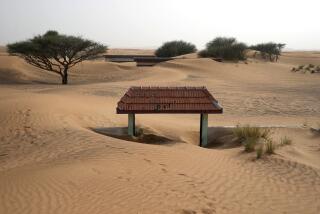The Roof Is Falling In on a Cultural Legacy in Zanzibar
- Share via
ZANZIBAR, Tanzania — Damp seeps through rotting beams and mildew-blackened walls. Roofs sag, balconies crack and shutters dangle from corroded hinges.
Bit by bit, Zanzibar’s fabled Stone Town is crumbling. Every year, a few more buildings collapse, leaving yawning gaps in the narrow, winding alleys lined with Arab palaces, Persian baths, British colonial offices, Indian shops and onetime slave chambers.
Sun, rain, wind and neglect have taken a toll on one of the world’s cultural treasures, the former capital of a trading empire stretching from Africa to the Middle East, Asia, Europe and the United States.
About 85% of the more than 1,000 buildings show signs of structural decline, says Abdu Sheriff, a historian and former curator of national museums. Conservationists estimate at least 200 have fallen in recent decades, including three this year.
Salim Mbarak moved to Stone Town from Yemen 54 years ago when the ancient heart of Zanzibar town was a prosperous commercial center. His fortunes faded with the neighborhood.
He now makes a paltry living selling bread in the street and pays the government $6 a month for a room off a courtyard crowded with drying laundry and water drums.
There are holes in his walls, the window frames and shutters have rotted away, and a sudden rain sends water streaming through the tin roof. Earlier this year, the house next door collapsed, leaving rubble piled two stories high.
“Before the revolution, these buildings were properly maintained,” Mbarak, 65, says as the Muslim call to prayer mixes with church bells. “Now they don’t repair anything -- but they increase the rent every year.”
Zanzibar, a semiautonomous archipelago off the coast of Tanzania, was once the center of a vast empire of Swahili city-states stretching from Somalia to Mozambique.
Through the centuries, the islands were colonized by the Portuguese, Omani Arabs made their capital here, and the British established a protectorate. They built fortunes on the slave trade and spices, making Zanzibar the leading exporter of cloves during the 19th century.
Stone Town remains Zanzibar’s commercial and cultural center, the seat of government, its main port and a major tourist attraction drawing more than 100,000 visitors annually.
Its varied cultural heritage is preserved in coral stone walls and imposing wooden doors, whose intricate carvings reveal their owner’s religion, wealth and status. It has been home to Arab sultans, Indian and Chinese merchants, European explorers and the late rock star Freddie Mercury.
“It is a living manifestation of cultural fusion and harmonization,” says Mwalim Ali Mwalim, head of the Stone Town Conservation and Development Authority set up to rescue the district.
Without maintenance, the buildings fall apart, he says. Mangrove poles used to support ceilings collapse if they are not replaced about every 15 years. When water seeps into the mud and lime used to plaster walls, trees start to grow out of them.
Stone Town’s decline began under British rule, when the slave trade was banned and Zanzibar started to lose its political and economic importance.
Independence from Britain in 1963 brought a bloody revolution by African residents against the Omani sultanate, seen as an exploiter for more than 300 years. Thousands of Arabs and others fled, taking with them much of the wealth and skills that had built Stone Town.
The new socialist regime took over abandoned buildings, leasing out rooms to rural migrants too poor to maintain them. The government showed little interest in preserving the old buildings, preferring to build large concrete apartment blocks for the swelling population.
Meanwhile, Stone Town’s economic fortunes plummeted with the decline in world prices for cloves and other exports. By the late 1970s, buildings were collapsing, causing numerous casualties.
Fatima Khamis Rashid, 36, moved to the neighborhood with her husband 15 years ago from Zanzibar’s impoverished second island, Pemba.
The couple and their eight children squeeze into two rooms above a curio shop. Their faucet has long stopped delivering water, the wooden ceiling beams are cracking and pieces of plaster tumble to the floor.
“Any time the ceiling can fall down on top of us,” says Rashid, wrapped in a blue veil in her dim kitchen.
Stone Town’s fortunes have rebounded some since the late 1980s, a period of racial reconciliation and economic liberalization that revived the neighborhood’s commercial activity. The government also began to see the district’s tourism potential.
With the help of the United Nations, the development authority was formed and a conservation plan drawn up leading to the 2000 proclamation of Stone Town as a World Heritage Site. But Mwalim says the body lacks the political clout and funding to turn its plans into reality.
Government pays the authority’s salaries and operating costs, but its annual conservation budget is less than $20,000 -- not enough to restore a single building, Mwalim says.
The authority relies on donors such as the Aga Khan Trust for Culture to fund key restorations. Among the show pieces are a former hospital called the Old Dispensary, and the House of Wonders, a ceremonial palace built for the sultan that was the first building here with electricity, running water and an elevator.
Private investors have also restored buildings, including some standout hotels, but most businesses have little interest in historical authenticity. Regulations governing the height of structures, building materials and colors used are routinely flouted.
As long as residents can’t afford to maintain the buildings, conservationists say, a cultural wonder will continue to crumble.
More to Read
Sign up for Essential California
The most important California stories and recommendations in your inbox every morning.
You may occasionally receive promotional content from the Los Angeles Times.












